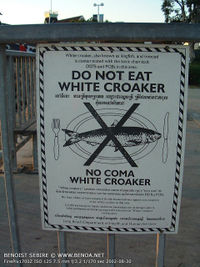Pollution and benthic fish

Benthic fish (unlike pelagic fish) live right above the surface of the sea floor. The sea floor soil typically accumulates contaminants which have a low water solubility (most contaminants are rather insoluble). Therefore, benthic fish are more often affected by diseases related to poor water quality, such as fin rot or epidermal tumors. These diseases occur much more often in areas with a high amounts of contaminants (such as the bay around Los Angeles in the 1970s), yet specific direct causal factors remain uncertain.[1]
Methylmercury
Methylmercury can reach high values in large carnivorous fish. These fish are also more active, causing them to need more oxygen. To extract more oxygen, they have to pump more water through their gills, causing them also to adsorb more contaminants. Unlike marine mammals and (possibly) sea birds, fish can't demethylate methylmercury, nor can they excrete it efficiently. Therefore old carnivorous fish often contain very large amounts of methylmercury, making them unfit for human consumption.[2]
Organochlorine compounds
The major effect of organochlorines is that they impair the reproductive functions and consequently threathen the survival of the species. So have white croakers in contaminated areas near Los Angeles a high organochlorine content and a reduced number of eggs.[3] Also the turbot in this region is affected by high organochline concentrations of the region: due the endocrine disruptive effects of these contaminant express 90% of the males female hormones. The contamination however doesn't seriously affect the reproduction of the turbot. [4]
The starry flounder population in the San Fransisco Bay displayed reduced breading success in the 1980s. Although the San Francisco bay had a relatively low PCB content, the eggs of the flounders displayed elevated PCB levels. Also the breading success of fish species in Europe might have been affected by relatively low levels of PCBs. [5]
Below you can find some links to Belgian case studies on ecotoxicology in benthic fishes.
Case Studies
Case study 1: PFOS contamination in bib and plaice in the Western Scheldt [6]Case study 2: Volatile organic compounds in North Sea fish [7]
Related articles
References
- ↑ Kennish M. J., (1998), Pollution impacts on marine biotic communities CRC Press 310 pp
- ↑ Clark, R,B., 1999. Marine pollution. Oxford University press, Fourth edition, pp 161
- ↑ Md. Shahidul Islam and Masaru Tanaka, 2004, Impacts of pollution on coastal and marine ecosystems including coastal and marine fisheries and approach for management: a review and synthesis, Marine Pollution Bulletin Volume 48, 7-8 Pages 624-649.
- ↑ http://www.sccwrp.org/view.php?id=278
- ↑ Sinderman, C.J. 2006. Coastal Pollution: Effects on Living Resources and Humans. CRC Press, Boca Raton, FL. 280 pp
- ↑ Hoff, P.T.; Van de Vijver, K.; Van Dongen, W.; Esmans, E.L.; Blust, R.; De Coen, W.M. (2003). Perfluorooctane sulfonic acid in bib (Trisopterus luscus) and plaice (Pleuronectes platessa) from the western Scheldt and the Belgian North Sea: distribution and biochemical effects. Environ. Toxicol. Chem. 22(3): 608-614
- ↑ Roose, P.; Brinkman, U.A.Th. (2005). Determination of volatile organic compounds in marine biota, in: Roose, P. (2005). Volatile organic compounds and related microcontaminants in the Scheldt estuary and the southern North Sea: method development and monitoring. pp. 85-108
Please note that others may also have edited the contents of this article.
|